
BUY IT AT AMAZON:
CLICK HERE!
STUDIO: Warner Bros.
MSRP:
$13.98
RATED: NR
RUNNING TIME: 100 Minutes
SPECIAL
FEATURES:
• Audio Commentary by Fred Astaire’s daughter Ava Astaire McKenzie and Film Historian Larry
Billman
• New Featurette: On Top: Inside the success of Top Hat
• Comedy Short: Watch the Birdie with Bob Hope
• Classic Cartoon: Page Ms. Glory
• Original Theatrical Trailer
It’s tough for today’s younger and entirely cynical viewer to be engrossed with a picture that’s well on it’s way of being slightly older than your grandparents and contains absolutely no redeeming social values, like heads exploding and people dressing up in crime fighting suits. Leave it to Leonard Maltin, on Top Hat‘s featurette: On Top: Inside the Success of Top Hat, to state the truth, even if I’m paraphrasing slightly (he only mentioned the first part, all you inepties out there). He’s entirely correct, and I’m sure that the idea of sitting down watching two long-dead people effortlessly sing and dance their way into the annals of film history makes you queasy and throws you into collegiate lecture style boredom. To counter attack this, there’s always some Chuck Norris movie on television (or a Delta Force 3 and Hitman review) to help ease your pain.

The Bates Motel was pretty strict.
Top Hat was the first expressly written title for the hoofing duo of Astaire & Rogers, the two perfectly coiffed and wrinkle free individuals whose names inspire a less than thrilled response ’round these parts. As it stands, though, the pair’s 4th collaboration is one of their best films. It was during this point that, as the featurette spills the beans on, director Mark Sandrich and crew mapped out the films defining features, as in exactly how much plot would occur before a dance number and what would occur when. Calling this formulaic was besides the point, as audiences then knew exactly what they were getting into when watching Astaire & Rogers burn up the Art-Deco dance floor.
The Flick
For a film that’s 70+ years old, most guesses that you’ll check this out are in your PKE Meter’s negative zone. Most Fred Astaire & Ginger Rogers films adhered to the basic principles of guy meets girl, they fall in love, guy looses girl, guy attempts to ‘woo’ girl back (without slow motion doves or two bitchin’ guns on each arm) and guy gets girl. As simple as that may read, it’s not as easy as it looks. For there are conventions to be dealt with, plot devices to pop out of the woodwork and supporting characters to add the necessary buoyancy and uplift to the further adventures of Astaire & Rogers.
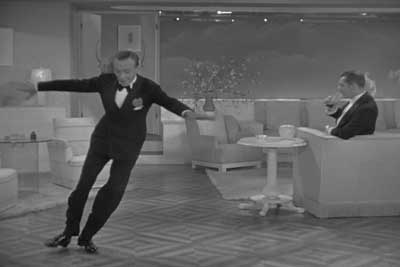
Not even the Earthquake could affect Jim’s drinking abilities.
Jerry Travers (Astaire) has foot problems. He feels the need to constantly be on the move, and it’s by his fancy footwork that he accidentally wakes up the sleeping Rogers in the hotel room below. The actual shot, moving downward almost through the hotel’s floor (it dissolves) until it rests on Rogers’ slightly bemused face is legendary. I think what sells it is Rogers’ look and the entertaining time all appear to be having. Her character, Dale Tremont, is an emotionally prone woman who’s quick to fall in love but hardened by the result of her misfortunate choice. While most of the time Rogers has to be content with just hanging around while Astaire sings to her, she’s more than capable on her own, engaging in her own right.
Astaire’s Jerry seems content that he’s involved himself in this imbroglio, whether or not he realizes it. His introduction, coughing in a very quiet room populated by the upper crust of London society, is a great first impression of the man. It instantly makes him identifiable, almost as if he’s like one of your good friends. There’s not a bad bone in his entire body (unlike Skeletor), and as the opposite of someone such as Bob Hope, who was famous for his snide and sinister one-liners, Astaire is just a simple song and dance man, connecting with the most primal urge to do just that and be entertaining on a visual level as much as on a friendly one. His talent is immense, and Top Hat allows him to be natural all the way through.

He often liked to brag about how far he shot.
When Rogers bounds up the stairs to complain about Jerry’s feet that the reverse effect occurs: Astaire is instantly smitten. Pierced to his core, he instantly lays down sand on the floor as so he can softly tap while she gets some shuteye. Astaire can barely sleep, so early in the morning he sends her countless amounts of flowers, buying out the hotel’s entire stockpile of pedals and sweet smelling stems from the hotel’s little shop of horrors. He continues his mighty quest to court her, and through these advances, Dale comes to believe that Jerry is actually Jerry’s producer-friend Horace Hardwick (the great supporting actor Edward Everett Horton), due to his name being where all of the flowers were billed. The thing is though; Dale is a good friend with Horace’s wife Madge (Helen Broderick), who’s currently shacked up in Italy, taking a breather. The fun in all of this is that everyone seems interconnected.
What follows is a gigantic comedy of errors, as the ways of mistaken identity wreak havoc on two forlorn lovers and those around them. What doesn’t help is that every time Dale is around Jerry, he appears to have items of Horace’s, like his briefcase or cane. Dale culminates this realization with a quick slap to Jerry’s face, after all, how could a married man even consider the thought of an infidelity? Dale thinks long and hard, and quickly decides: she’s off to Italy. Tagging along with her is Alberto Beddini (Erik Rhodes), who just so happens to provide Dale her form fitting clothes and relishes the idea of going to such a fashioned place. Upon learning of this escape, Jerry tricks Horace into chartering a weekend flight to Italy. Should Horace say no, Jerry, like all good friends, won’t perform. Sexual vagueness intended. Or not.
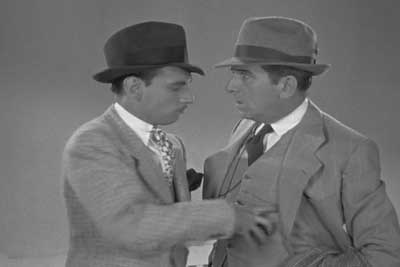
Then, someone offscreen shouted: FINISH HIM!
There, in an Art-Deco version of Italy, or Venice, complete with its deeply dyed canals and entirely-too-white set design, Madge learns of her husbands’ discretions and actually seems to go along with it. On the surface, she’s shrugging all of this off. Madge can’t believe her neurotic man would even consider such a thing even during their dinner conversations. Jerry soon interrupts, playing it his own foil, as Madge just thinks he’s attempting to relentlessly court her friend. Dale, meanwhile, thinks Madge is allowing her husband to engage in such deviant behavior. The result is that Dale finally gives in as Jerry sings her Irving Berlin’s heralded blockbuster tune "Cheek to Cheek" for a small moment. Unfortunately for him, Dale still isn’t buying his routine, let alone Madge’s acceptance of these shenanigans, so it’s up to the powers that be to put everything into their places lest everything get smashed into oblivion. Did I also mention that Dale is planning on heading to the altar with Beddini?
It’s within all of these twists and turns that the script, by Astaire & Rogers staples Allan Scott and Dwight Taylor (they both scribbled Follow The Fleet and Gay Divorcee), shines the brightest. It’s a cornucopia of razor-sharp bon mots, little snide comments, and tremendous wordplay that ranks alongside Swing Time as one of their most cohesive films. Additional credit goes alongside Production Designers Van Nest Polglase and assistant Carroll Clark, who’ve created a spectacular escapist world, filled with enough ‘Big White Sets’ to make anything stand out. Their Art Deco world, especially the elephantitis of the Italy town square doesn’t stand in as Italy, but rather suggests something like Italy, via the skewed entertaining world of Astaire & Rogers. Absolutely nowhere in the developments do you feel that these performers stand out alongside the immaculate staged environments, rather it’s almost too easy how quickly you go along with their world.

Visitors to our Sex Forum had many happy memories.
A definite advantage, besides the ones mentioned is the stellar supporting cast, one of the staples of Astaire & Rogers films since the get go. Here, Edward Everett Horton is devilishly delightful as a neurotic producer. Granted, he plays about the same role in every single film in which he’s coupled as Astaire’s best friend and confidant. Here he’s able to perfect his delivery with a series of double takes, a smashing sense of entitlement that is thrown into the wind and a plot development that allows us to relish in the squeamishness he’s forced into. Butler Bates is played the great character actor Eric Blore, who was famous of his delivery of using plurals for his singular status. They are wonderful to watch and they’re expressive use of their face is priceless, all the way down to their tricky ways they use to help out their employer.
Director Mark Sandrich, collaborating for his second time with the famed duo, is basically working with Astaire’s credo of "either the camera dances or I do". Luckily enough, both understood that to break away from the post-sound style of the immortal Bubsy Berkely, they’d have to let the performances speak for itself, thus you get a lot of wide shots that show each individual performance working on its own. This doesn’t call attention to itself as Berkley did having the movable camera going through legs and fountains and garbled gold digging panties, but allows the actors motions to speak for themselves, using what Larry Billman on the commentary track refers to as "Astaire’s body as an instrument of dance". Still, Sandrich does lather on the mixed up identity emotions fairly well and the result is a splendid film that works because of everything clicking together; from the direction to the Art Deco designs and the work of two intensively talented performers who put on their Top Hat, White Tie and Tails and work it to you, like the Ritz.
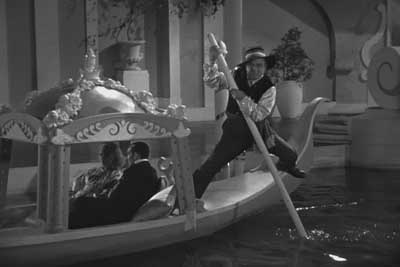
An early cut scene from LXG.
If you’re a casual fan of older films, you could do a hell of a lot worse than Top Hat, you could be watching any quota quickie. If you’re repulsed by the slightest sound of singing and dancing, you’re most likely a hardened douchebag. Keep on shining. If neither or these things fail to strike your fancy, you might be a Eunuch. I’ll have the reincarnation of Madeline Kahn check on that one.
9.0 out of 10
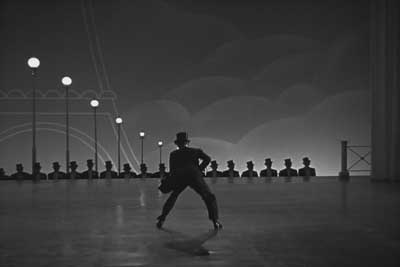
As the horde of men approached, the penile projectile was all he could think of.
The Look
Fullscreen! Don’t panic, as Widescreen was introduced some 18 years later. The 1.37:1 aspect ratio, as it stands, is spectacular. The film is rather grainy, but not too noticeable considering its spine bent, cane-using age. Where the imagery really shines is in the relative delineations between blacks and whites, as the contrasts are astounding, especially in high traffic areas like the hotel rooms and ‘fake’ Italy.
8.5 out of 10
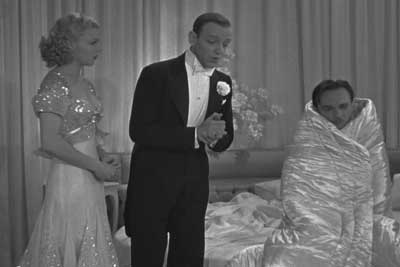
"You know, you might want to consider circumcision…"
The Noise
Ear-splitting mono. My center channel exploded forth with the sounds of Irving Berlin and was awash in a grandiose aural level that made my ears bleed. In reality, this is a nice track that I assume has been cleaned up. The audio levels are consistent throughout the entire film and don’t have you reaching for the plus button, unless you saw the film during its original theatrical release.
7.5 out of 10
The Goodies
Warner continues their night-at-the-movies style of releasing these much-loved older films with a wealth of extras. These might not be related to the film entirely, but it certainly feels like you’ve stumbled upon some entertaining goodies. Surely, they’ll be ignored by those mentioned previously, but it’s their loss.

Another satisfied customer of Hellraiser’s puzzlebox.
First, we get an entirely too informative commentary track with Fred Astaire’s daughter Ava Astaire McKenzie and Film Historian Larry Billman. Mrs. Astaire McKenzie does have a lot of engrossing tidbits to say, as they’re especially fascinating if you don’t have a clue about growing up with the legendary song and dance man. She has some great recollections, even if she’s relatively mute compared to Billman. The real meat and potatoes of the track is his sheer enthusiasm for the film itself. He’s consistently presented as if he’s shouting you the information, but he just seems excitable. His near monopoly on the topic of Top Hat is astounding, as he reaps across a variety of information from his proclaimed BWS (Big White Sets), intensive biographies of character actors Edward Everett Horton and Eric Blore, production facts, plot devices, what the costumes do for the actors (especially Rogers) and the relationship between Astaire and his choreographer/friend Hermes Pan. This was a great listen and worth just about anyone’s time.
They’ve also concocted a new featurette: On Top: Inside the success of Top Hat (runtime: 18:20), where a wealth of scholars, pundits, and people like the illustrious Leonard Maltin expound on their love of Top Hat and what it means to be a musical lover. Exceptional details are presented on the relationships between Sandrich and the plot (he’d graph everything out, like a focus group!), the cinematographer David Able and his remarkable skill and artistry, even Fred’s relationship with fellow choreographer Hermes Pan, which sadly does not include Pan attempting to join S.P.E.C.T.R.E. It’s a little too short, considering the amount of history they whip through at break-neck pace, but it does leave you with the impression (if you didn’t have it already) that you’ve learned something, Poindexter.

I slept with your Mom! Thank you, goodnight!
Bob Hope even makes an appearance in the comedy short film – Watch the Birdie (runtime: 18:16). Hope’s notorious one-liners are out in full force, with him cracking wise at every opportune moment, even at the most inappropriate ones. His chutzpah could lead to confusion that he’s an uber asshole, always wanting to cause maximum discomfort between his ‘victims’, but he’s just really a rotten, dirty prankster. The plot centers around his decision to marry his girlfriend (‘so he won’t have to think about it anymore’) and the trouble it causes between her little sister and father-to-be. While they’re all aboard a luxurious steamship, the father-to-be arranges some comeuppance for Hope via the form of an overextended customs search once they land (just like now – only less terrorists). It’s there where the short sort of putters out, and quite frankly I would have been happy with half of the length shaved right off. As it stands, though, it’s pretty humorous, and while not laugh-out-loud funny, it does make you smile at all the stupid things Hope does with his pocket full of tricks.
The classic cartoon short Page Ms. Glory (runtime: 7:43) makes its home video debut as well. Supposedly, this is a milestone for all those Tex Avery fans out there, as the style is notoriously poking fun at Bubsy Berkely’s use of style, as the short concerns a Bellboy at a local hick town hotel who falls asleep and wakes up in the middle of a bulging Art Deco city. The details in the animation are astounding, all the way down to the nuances in style, emotions and relative implications that Ms. Glory is a lady of the night, always ready for a "little romance". Kidding about the last part, but I was just looking too deeply into that. Finally, there’s the theatrical trailer (run time: 1:01) which is scored to Berlin’s The Piccolino and pretty much shuttles aside everyone else, including Astaire & Rogers, for Berlin and his insanely composed musical pieces.
8.0 out of 10
The Artwork
 Intense class all the way. If I remember correctly, the poster was a fun sight-gag in Chow’s Kung Fu Hustle, and if Stephen Chow likes this film enough to put it in his film, you should at least check it out. Don’t worry about my sub-par words. The original artwork showcases the two stars in mid dip, the right amount of motion and emotion is displayed on Astaire’s ready-to-sing face and Rogers "you have bad breath" smile. It doesn’t quite look like her, but I think the original artists have succeeded in turning out something that is entirely related to the film, the summing up of the necessity of dance as related to the stars. Now if you’ll excuse me, I’m off to try and get these goddamned Irving Berlin songs out of my head.
Intense class all the way. If I remember correctly, the poster was a fun sight-gag in Chow’s Kung Fu Hustle, and if Stephen Chow likes this film enough to put it in his film, you should at least check it out. Don’t worry about my sub-par words. The original artwork showcases the two stars in mid dip, the right amount of motion and emotion is displayed on Astaire’s ready-to-sing face and Rogers "you have bad breath" smile. It doesn’t quite look like her, but I think the original artists have succeeded in turning out something that is entirely related to the film, the summing up of the necessity of dance as related to the stars. Now if you’ll excuse me, I’m off to try and get these goddamned Irving Berlin songs out of my head.
8.5 out of 10